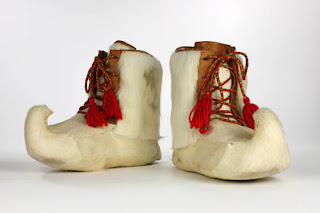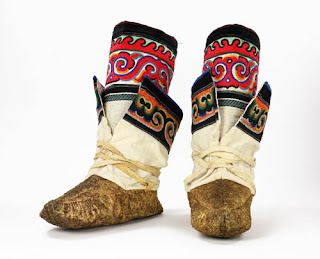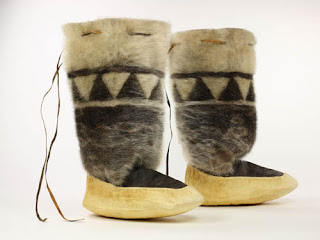The Bata Shoe Museum’s collection of footwear worn by the cultures living in the world’s circumpolar region is the largest comprehensive collection in existence. These shoes and boots are made to withstand some of the harshest climates that humans can endure. Whether they are made from seal, caribou, or fish, they can provide the warmth and protection that is needed on snow, land, ice and in water.
The Bata Shoe Museum is committed to the collection, documentation, and care of the circumpolar collection, and we are equally committed the study of circumpolar peoples through field trips and living ethnographies. It is through these field studies that we can explore the construction of the footwear and the sewing techniques of the women who made them. This blog entry will look at some of the circumpolar artefacts in our collection from various regions of the world.
The upturned toes and colourful felt and leather decoration on these Anar Saami reindeer hair boots are typical of Saami footwear. They are made from the relatively rare white parts of a reindeer hide which was reserved for weddings and important ceremonies. This pair was made in Finland by Helena Naakkaalaajaarvi.
 |
| Inari, Finland, 1990. ©2010 Bata Shoe Museum |
Colourful and elaborately appliqued cotton boot shafts and liners are the hallmarks of Nanai boots. Made in 1994 by Anna Michailovna Beldi of Sakhalin Island – which is just between Japan and mainland Russia, these boots feature fish skin soles and vamps which would be water-proof and lightweight.
 |
| Sakhalin Island, Russia, 1994. ©2010 Bata Shoe Museum |
Most Ungava seamstresses follow traditional kamik patterns for their haired seal skin boots. This pair was made by Mary Luuku of Ivujivik and can be identified as being for a girl or a woman because of the dark triangle skin pieces sewn horizontally into the boot shaft. Seal skin is a popular choice for Inuit kamiks because of its water resistant qualities.
 |
| Ivujivik, Canada, 1981. ©2010 Bata Shoe Museum |


